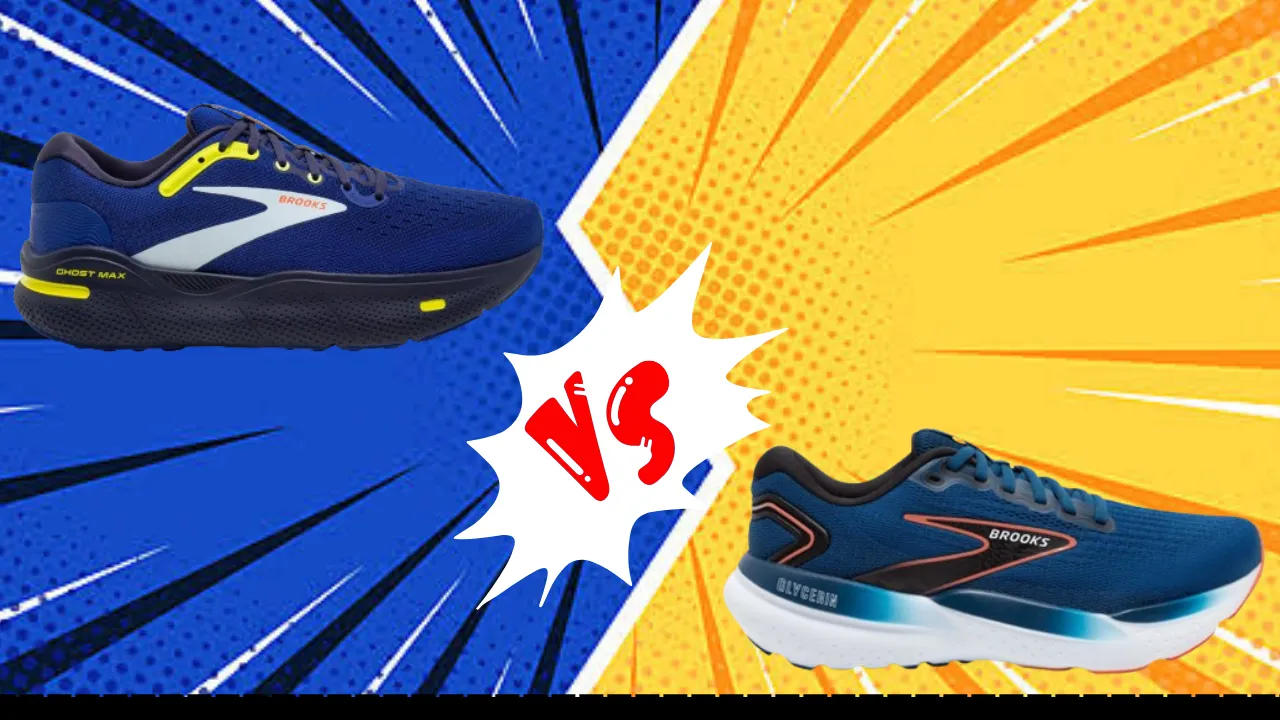If you’re a runner searching for your next reliable daily trainer, two of Brooks’ most popular neutral cushioned models should be on your list – the Ghost Max and the Glycerin 21. Both shoes provide soft, stable cushioning and durable protection for miles of comfortable running.
The Ghost Max builds on the trusted Ghost lineage with a completely revamped midsole design that offers more responsiveness and speed for faster paced efforts. The Glycerin 21 retains the beloved plush feel but gets modern upgrades like a lightweight mesh upper to improve fit and breathability.
So which Brooks trainer is right for you? Read on for a detailed breakdown of how the Ghost Max and Glycerin 21 stack up across critical performance factors.
Similarities And Differences Between Brooks Ghost Max and Glycerin 21:
| Feature | Ghost Max | Glycerin 21 |
|---|---|---|
| Launched In | 2023 | 2024 |
| Stability | Neutral | Supportive, Stable |
| Flexibility | Moderate | Moderately Flexible |
| Sizing | Standard | Standard |
| Weight | Men’s 10.0 oz, Women’s 9.0 oz | 9.30-10.50 oz |
| Cushion | DNA Loft (Responsive) | Plush, Comfortable DNA Loft |
| Outsole | Segmented Rubber | Durable Rubber |
| Midsole | DNA Loft | DNA Loft |
| Upper | Engineered Mesh | Engineered Mesh |
| Price | $140 | $160 |
Feature Comparision:
Material:
The Ghost Max uses a full-length DNA Loft midsole made from Brooks’ proprietary foam which offers soft, resilient cushioning that maintains its properties over hundreds of miles. The segmented rubber outsole provides reliable grip while the engineered mesh upper is breathable and comfortable with ample room in the toe box.


The Glycerin 21 shares similar DNA Loft cushioning tuned to deliver Brooks’ signature soft and plush underfoot feel run after run. The outsole uses high abrasion-resistant green rubber in key high wear areas for protection, and the newly designed upper combines support and flexibility through engineered mesh with less layers for a sock-like fit.
Durability:
Testers found both the Ghost Max and Glycerin 21 to be durable options capable of high mileage thanks to quality materials like Brooks’ DNA Loft foam that retains cushioning capacity plus abrasion-resistant outsoles.
The Ghost Max may have a slight edge in outsole durability thanks to its full rubber coverage versus the strategic rubber placement of the Glycerin that leaves some exposed midsole foam.
Fit:
The Ghost Max and Glycerin 21 share an anatomical last and standard sizing to accommodate most runner’s foot shapes. The Glycerin 21 caters to overpronators needing more midfoot support with guide rails integrated along the medial and lateral sides.


The Ghost Max offers a roomier forefoot and less structural elements overall for more neutral runners wanting uninhibited foot motion. Both models eliminate irritation with flat-knit integrated tongue construction to prevent hot spots.
Stability:
While the Ghost Max provides an inherently stable platform, the Glycerin 21 takes stability a step further with its co-molded GuideRails Support system built seamlessly into the full-length DNA Loft midsole. This allows for smoother transitions and less medial compression for overpronators.
However, truly neutral runners with efficient gaits may find the guide rails slightly restrictive when pushing paces. The Ghost Max gives less midfoot structure for more natural foot motion at faster speeds.
Cushioning:
Runners will feel the plush DNA Loft foam immediately in the Glycerin 21 which feels remarkably soft yet still provides adequate underfoot support. Its pillow-like ride makes the shoe ideal for recovery days or slow long runs when you just want padded protection.
The Ghost Max leans slightly firmer to enable a more responsive ride when accelerating strides, though it still provides ample cushioning for most runners. Overall stack height is slightly lower in the Ghost Max as well which brings feet closer to the ground.
Value:
At $150, the Ghost Max delivers responsive cushioning and a durable outsole suitable for daily training at a reasonable price point.
The Glycerin 21 costs slightly more at an MSRP of $160, justified by its ultra-plush DNA Loft foam and stability features like the GuideRails support which require more complex manufacturing.
For neutral runners focused on cushioning, the Ghost Max provides better value given its lower cost and lighter-weight design. Overpronators who require guidance and plush comfort underfoot may find the Glycerin 21 worth the extra $10 investment.
Overall both models are sound values thanks to premium materials and proven construction that allows hundreds of miles of comfortable mileage. In the end, choose between responsive stability at $160 or soft support for $150 when choosing between the Glycerin 21 and Ghost Max.
Performance Comparision:
For Walking:
While designed specifically for running, both the Ghost Max and Glycerin 21 can double duty as comfortable walking shoes thanks to their soft midsoles that retain cushioning and support even during lower-impact activities.
The Glycerin’s ultra-plush DNA Loft cushioning feels gentler underfoot which some walkers may prefer for high step counts. However, the roomier toe box and smooth interior lining of the Ghost Max allow more natural toe splay and motion for longer walks without irritation.
For Running:
As expected as a versatile neutral trainer, the Ghost Max holds a slight edge for faster-paced running sessions or tempo days where quicker turnover is prioritized.
Multiple testers found the smooth heel-to-toe transition and snappier DNA Loft foam kept their legs fresher even during marathon distances compared to the Glycerin 21 with its softer ride.
For recovery days or easy pace runs, the Glycerin 21 remains a top choice due to its extremely comfortable midsole that retains plush softness long into miles.
For Plantar Fasciitis:
The Glycerin 21 seems best equipped specifically for battling stubborn plantar fasciitis or similar conditions, where maintaining ample cushioning and support under the arches is critical for managing pain and inflammation.
The Ghost Max lacks structural elements in the midfoot, though testers with sensitive feet still found it adequately comfortable for short to moderate distances. During longer endeavors, the extra stability of the Glycerin pays dividends.
For Standing All Day:
Retail workers, servers, and others who are on their feet all day will appreciate the Ghost Max and Glycerin 21 for reliably delivering cushioned step-in comfort hour after hour with little mid-sole packing out or loss of shock absorption over time.
Again, the extra stability features engineered into the Glycerin 21’s midsole likely reduce general foot fatigue and arch strain better for extended periods of use. But the Ghost Max still holds its own with a smooth liner and comfortable heel section that helps avoid Achilles rubbing issues.
Final Verdict:
For runners seeking cloud-like softness underfoot that they can disappear into for recovery days and easy mileage, the Glycerin 21 is likely the winner with its feathery-plush DNA Loft foam and dedicated midfoot guide rails to support overpronation.
However, neutral runners wanting a durable shoe that can handle both slow paces but also uptempo days should still consider the Ghost Max for its fuller ground contact, lively cushioning, and roomy fit.
Both models check the boxes for consistent mile after mile while keeping your feet happy along the way.

